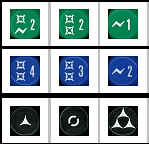A couple weeks ago, the committee was tweaking some cards in season 4 in regards to how they modify their attacks, and the terms “damage ceiling” and “damage floor” came up. I noticed that we were using these terms to mean different things, myself included, and to help facilitate better communication, I did some research and put together a sort of glossary for the common understanding of what these terms mean in relation to dice results and how different attack and defense modifiers affect damage ceilings and damage floors. I wanted us to be able to have a common understanding of how the different abilities we put on a card would affect how that card might perform at different ends of the variance spectrum. That is to say, how will this attack do even with the worst possible roll, and how insane can it get with a perfect roll? I was so pleased with my creation, I decided I’d share it with all of you. Hey, it’s not recycled content if it’s the first time you’re all seeing it!
Based on this and this as reference points from outside the committee, from IA and Armada communities:
Damage Floor: The lowest possible damage an attack can deal, including max defense dice rolls for the defender involved.
Damage Ceiling: The highest possible damage an attack can deal against 0 defense (white blank, black  while weakened, Bantha, etc)
while weakened, Bantha, etc)
Average Damage: The average amount of damage, or mean damage, based on the dice probability, including defense dice and surge abilities involved.

Let’s take the humble elite Stormtrooper as an example. The dice results in the left column below represent the stormtrooper’s damage ceiling, the maximum damage that can be rolled with a blue and a green dice and a surge for +2 damage, which is 5 damage. The results on the right column show the damage floor, which is the lowest possible result, in this case 2 damage (because each surge ability can only be used once per attack). But because most figures in the game do roll 1 defense die, it’s important to also check damage floors against defense dice as well. For the white die it’s easy enough because the damage floor will usually be 0 against an unmitigated Dodge result, and the damage ceiling will be the same as no defense die because of the blank, so let’s look at a black die instead.

For damage ceiling, we are again trying to determine the maximum possible amount of damage with the given parameters, which in this case is a normal attack against a black die. In this case, the attack ceiling drops from 5 to 4, because for both of the black die’s weakest results, there is a combination of blue and green dice that deals 4 damage through it, but it is now impossible for the these attack dice to deal more than 4 damage against the black die. The damage floor also drops from 2 to 0, because the black die has the triple block result, as well as 2 sides with double blocks that would also result in 0 damage.

Average damage is a bit more difficult to calculate in Imperial Assault, and it’s not as simple as just adding the ceiling and floor values and dividing by 2. The Imperial Assault Attack Calculator can give you a decent ballpark of that number, but because of how dice and surge abilities work in Imperial Assault, the only real way that I know of to determine an attack’s average damage is to check every possible dice roll and average the damage results. This makes finding the average damage exponentially harder for each dice you add to the equation, both attack and defense. Finding the average of 2 dice is 36 results, 3 dice is 216 results, and 4 dice is 1,296 results, 5 dice is 7,776 results, etc, and because every result has to be evaluated individually, it’s not easy to find the average for more than 2 dice with just a calculator and a spreadsheet. I’m sure there’s some advanced programming that could easily handle it for all possible numbers of dice, but that is beyond my grasp. I can tell you however that the average damage of an elite stormtrooper (against 0 defense dice) is 3.84, though I know that a single black die lowers that average significantly, but I’m not going to go through 216 dice results to figure that out.
So now to apply our understanding of damage ceiling and damage floor to understanding how different attack modifiers can affect these values. Below is the list I created for the committee of how each type of common attack modifier changes either the damage floor, damage ceiling or average damage for an attack.
- Pierce raises the average damage and damage floor (by removing blocks from defense that would otherwise lower the attack’s damage floor), but does not increase damage ceiling, because damage ceiling assumes 0 blocks on defense.
- Rerolls raise average damage, but doesn’t raise the damage ceiling or damage floor because you can still only roll what’s possible on the dice, and you could still reroll into the same worst-case roll, and you can’t reroll into a better result than your best possible roll.
- Adding Attack Dice raises the average damage and damage ceiling as that now changes the maximum
 a figure can deal with their dice roll. Only red dice will increase the damage floor because the other 3 dice have sides with 0 damage on them, so if all your attack dice roll
a figure can deal with their dice roll. Only red dice will increase the damage floor because the other 3 dice have sides with 0 damage on them, so if all your attack dice roll  , you’re minimum damage doesn’t change by adding another
, you’re minimum damage doesn’t change by adding another  .
.
- Adding
 raises the attack floor, attack ceiling, and average damage. It’s probably the strongest ability that you can give to an attack that’s listed here except for adding a red die.
raises the attack floor, attack ceiling, and average damage. It’s probably the strongest ability that you can give to an attack that’s listed here except for adding a red die.
- Adding
 raises average damage and, if there is a [
raises average damage and, if there is a [ : +X
: +X ] ability available, the damage ceiling because now you can roll max
] ability available, the damage ceiling because now you can roll max  symbols on the dice and still get to use your
symbols on the dice and still get to use your  : +X
: +X , but it doesn’t increase the damage floor (again, extra
, but it doesn’t increase the damage floor (again, extra  doesn’t help when you roll all
doesn’t help when you roll all  ).
).
- Adding additional
 abilities that convert one
abilities that convert one  into +1
into +1  raises the damage floor and average damage without raising the damage ceiling, because it helps to mitigate rolls where there are only surges and no
raises the damage floor and average damage without raising the damage ceiling, because it helps to mitigate rolls where there are only surges and no  results on the dice, as well as mitigating the problem of oversurging on attacks where you roll too many surges at the expense of
results on the dice, as well as mitigating the problem of oversurging on attacks where you roll too many surges at the expense of  results. It usually doesn’t increase the damage ceiling because in most cases each attack die trades 1
results. It usually doesn’t increase the damage ceiling because in most cases each attack die trades 1 for 1
for 1 on its best side. The exception to this is the yellow die, whose best side provides an additional surge, so attacks with a yellow die can see their damage ceiling increase with an added surge for +1 damage ability, but this can be fixed by changing it into a surge for Pierce 1 instead.
on its best side. The exception to this is the yellow die, whose best side provides an additional surge, so attacks with a yellow die can see their damage ceiling increase with an added surge for +1 damage ability, but this can be fixed by changing it into a surge for Pierce 1 instead.
- Setting an attack Dice face to a specific side, ala Ezra’s deployment or Yoda’s command card, raises the damage floor and average damage without raising the damage ceiling, as this is effectively adding symbols to the attack, but not in excess of what could already be naturally rolled on the attack dice.
- Addding Defense Dice lowers the damage floor and average damage, but because both defense dice have sides with 0
 on them, they don’t always lower the damage ceiling (it depends on what surge
on them, they don’t always lower the damage ceiling (it depends on what surge abilities the attacker has).
abilities the attacker has).
- Adding
 s lowers the average damage and damage ceiling, and lowers damage floor if the attack doesn’t have any pierce. Much like adding
s lowers the average damage and damage ceiling, and lowers damage floor if the attack doesn’t have any pierce. Much like adding  , it is one of the best defensive modifiers.
, it is one of the best defensive modifiers.
- Removing Attack Dice lowers the damage ceiling and average damage, but doesn’t lower the damage floor unless it’s removing a red die before dice are rolled, because again, non-red die can roll sides with 0
 and contribute nothing to a roll that is already terrible.
and contribute nothing to a roll that is already terrible.
- Finally, abilities that reduce Pierce, such as Zillo Technique mainly, also reduce an attack’s damage floor without reducing it’s ceiling. This means Zillo technique is at it’s best when either the zillo players rolls great on defense, or the attackers rolls horribly and needs to rely on Pierce to push meager damage through. It’s a card that exacerbates bad results for the attacker.
Understanding how these mechanics affects the outcomes of an attack’s best, worst, and average possible results helps the committee to better factor dice variance into our designs. For example, if we have a figure whose attack we want to increase the damage floor of without increasing its damage ceiling, so that it can have a more consistent attack without being able to get huge damage spikes, we’ll look at adding Pierce 1 to the attack as well as rerolls and additional surge for +1 damage abilities. These abilities help to make an attack more consistent without increasing the maximum damage that it can deal. If we’re more interested in an attack with a big damage swing from minimum to maximum, we might look at adding extra non-red dice or extra built-in surges. And if we want an attack to have a very narrow and controlled damage profile, we’ll look at possibly reducing the amount of dice rolled and replacing them with straight up built-in modifiers like +1![]() .
.
Generally, the committee has been more focused on controlling the big damage spikes that have dominated Imperial Assault since Jabbas Realm, and more interested in creating more attacks that are more consistent with higher damage floors and lower damage ceilings, or have higher damage ceilings but only situationally. Controlling damage ceilings on attacks is especially important for figures that have ways to attack multiple times, like Biv Bohdrick, which is why the -1![]() from switching from Brutality to Multi-Fire was so important. But that’s not to say that we’re afraid to play around with variance in our designs. There’s actually a figure in season 4 that is all about masterfully manipulating dice variance in clever ways that I’m really excited to show off in July.
from switching from Brutality to Multi-Fire was so important. But that’s not to say that we’re afraid to play around with variance in our designs. There’s actually a figure in season 4 that is all about masterfully manipulating dice variance in clever ways that I’m really excited to show off in July.
Understanding how all of these contribute to a figure’s damage output has allowed the committee to make more powerful 2-dice figures than ever before (like Bossk and Loku, and many more to come) and has helped us to laterally redirect the upward trending damage curve in the game that was started with Jabbas Realm, rather than blindly follow it upward towards power creep. Not every expensive or mid-cost figure needs to be able to fire a death star laser or roll buckets of dice to be offensively viable, and these are the tools that we use to help us solve that puzzle. Hope you enjoyed this article, see you all next time.


 a figure can deal with their dice roll. Only red dice will increase the damage floor because the other 3 dice have sides with 0 damage on them, so if all your attack dice roll
a figure can deal with their dice roll. Only red dice will increase the damage floor because the other 3 dice have sides with 0 damage on them, so if all your attack dice roll  , you’re minimum damage doesn’t change by adding another
, you’re minimum damage doesn’t change by adding another  on them, they don’t always lower the damage ceiling (it depends on what surge
on them, they don’t always lower the damage ceiling (it depends on what surge